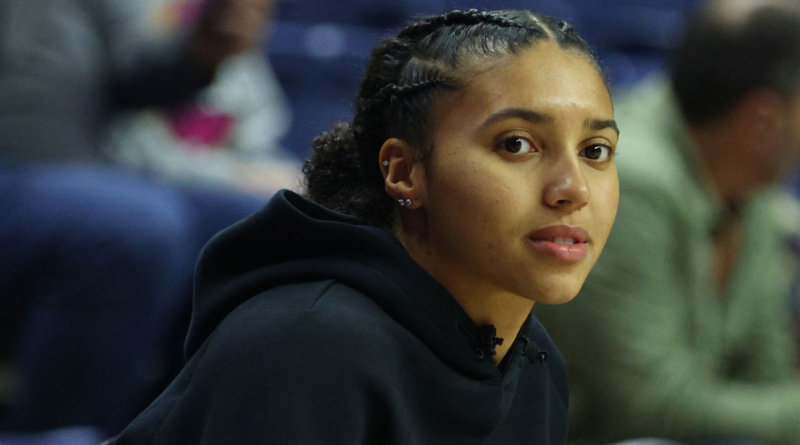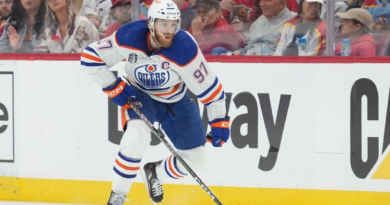How Azzi Fudd's injury impacts UConn, women's college basketball
After so much preseason optimism over what a healthy UConn could do in the 2023-24 women’s college basketball season, it has been extinguished in less than a month of play: Junior Azzi Fudd will miss the rest of the season with ACL and medial meniscal tears in her right knee, the Huskies announced Wednesday, the latest in a slew of season-ending injuries the program has dealt with in recent years.
Fudd’s injury is her third in three seasons in Storrs. A foot injury limited the former No. 1 recruit from the class of 2021 to 25 games her freshman season. Knee injuries sidelined her on two occasions as a sophomore, with her returning in time for the NCAA tournament and playing 15 games in all.
Then, barely a week into the 2023-24 season, after just two games, Fudd suffered the ACL and meniscal tear in practice. Coach Geno Auriemma said Fudd went up for a shot and remarked afterward that something felt funny before leaving for the training room. The sharpshooter, whose jumper has been called textbook by Stephen Curry, previously tore the ACL and MCL in her right knee in April 2019.
UConn already is without Jana El Alfy due to an Achilles injury she suffered in July playing with Egypt in the FIBA U19 World Cup. Last year, 2021 national player of the year Paige Bueckers and then-freshman Ice Brady were sidelined the entire year with an ACL tear and a dislocated patella, respectively, that occurred during the summer.
ESPN’s Michael Voepel, Charlie Creme and Alexa Philippou dissect what Fudd’s injury means for the No. 6 Huskies’ championship aspirations and for Fudd moving forward.
How will Fudd’s absence impact the Huskies? How will the lineup change? Which players will see more playing time and must step up?
Creme: Aubrey Griffin and Qadence Samuels are the first two players who come to mind. As a fifth-year senior, and one who also missed a season due to injury, Griffin has the experience to equal Fudd. She stepped into the starting lineup against Maryland and produced nine points and 13 rebounds in 28 minutes.
Freshman Samuels can provide at least a portion of the perimeter shooting lost with the absence of Fudd. Neither possesses Fudd’s overall talent, but Griffin has performed in these situations before and Samuels is a top-50 recruit — and already the Huskies’ most prolific 3-point shooter this season.
Philippou: Caroline Ducharme. It seems ages ago that Ducharme carried the Huskies when Bueckers and Fudd were sidelined for a chunk of 2021-22, looking every bit the top recruit she was deemed before her arrival to Storrs. Since then, she has dealt with concussions and neck stiffness, and she hasn’t been the same player consistently. She’s struggling to start this season, scoring 16 points and playing 59 minutes through four games.
If the junior can stay healthy, and if she emerges as the best version of herself — hit 3s, get to the rim, help UConn get its transition game going — it would be a huge swing in the Huskies’ favor. She’s critical to their effort to stretch the floor — something they desperately need, given Fudd’s injury — and if she can give them 10-15 points per game, it would take a massive load off Bueckers’ and Aaliyah Edwards‘ shoulders.
How might Fudd’s injury affect UConn mentally after so many recent injuries, especially as the Huskies thought their core was finally healthy?
Voepel: From the time Fudd and Bueckers committed to UConn, there was so much enthusiasm about them playing together and how they could become two more in the long line of Huskies greats whose careers were intertwined. They started together in the 2022 national championship game, but injuries to both have prevented the kind of on-court partnership they hoped for.
It has taken a toll on them and on the team as a whole. It’s hard to see anyone sidelined by injury. When it happens to two highly skilled teammates more than once during a three-year period, the emotional pain the program must deal with is substantial.
But one thing UConn is known for is the mental fortitude and discipline instilled in players for decades. The coaching staff hasn’t let up on that but has to balance it with how the cumulative effect of so much disappointment affects the players.
Creme: This is another emotional gut punch to a program that has been absorbing them at an alarming rate the past few years. Who could blame any of the Huskies for saying the likes of “Not again” or “Why us?” or “How can this keep happening?”
But that likely won’t last long. When Bueckers went down with her first knee injury two years ago, the Huskies lost their next game to Georgia Tech but rebounded to beat UCLA the next time out. There were some ups and downs, but the Huskies went 15-4 without Bueckers. Granted, that team had veterans such as Evina Westbrook, Christyn Williams and Olivia Nelson-Ododa; that is where the leadership of Bueckers, Edwards and Nika Muhl becomes so crucial this time.
Upcoming games against UCLA (Friday), Texas (Dec. 3) and North Carolina (Dec. 10) will be a test, but last Thursday’s response against Maryland without Fudd should be encouraging.
0:17
Azzi Fudd splashes a 3 for UConn
Azzi Fudd steps into a 3-pointer and drains the shot for the Huskies.
Philippou: This UConn senior class dealt with COVID-19 as freshmen, and then a slew of injuries that have made their UConn experience far from what they envisioned. It has unquestionably taken a mental toll and required resilience. But the X factor this season is the leadership from Bueckers, Edwards and Muhl. Players have said previously that it was easy to blame their problems last season on the onslaught of injuries as opposed to actually working to address them.
Accountability among the group has also been an issue at times, players have admitted — they are so close that they don’t want to hurt each other’s feelings by calling out what someone is doing wrong or not doing enough of. That came back to bite them, they said, in the Sweet 16 against a tough team in Ohio State.
For UConn to get to where it still aspires to go this spring, the Huskies have to shed that earlier mindset entirely. In a way, because Fudd’s diagnosis is season-ending — as opposed to last year when she was able to return in time for the postseason — perhaps it prevents them from falling into last year’s trap.
What does this latest injury mean for Fudd, and what lies ahead?
Philippou: Devastating is really the only way to describe this situation for Fudd. She came in as one of the most hyped recruits in some time and instead will have played in only 42 games after dealing with three injuries in three years, each one progressively more serious than the last. There was so much anticipation, internally at UConn and externally, over what Fudd and close friend Bueckers could do as perhaps the best backcourt duo in the country; now they’ll have only played 17 games together over three years due to their respective injuries, and if Bueckers opts to leave for the WNBA after this season, we’ll have already seen the last of them on the court together.
And it’s yet another blow for Fudd to have to deal with an ACL again after overcoming ACL and MCL tears in high school. She knows exactly the challenges this rehab process will entail. It’s difficult to imagine the mental and emotional toll Fudd faces being sidelined yet again, after working so hard to prepare for her junior season, and this time for the longest stretch yet.
The preseason excitement over what Fudd could do with a fully healthy season has now been replaced with not just disappointment over the short-term implications but concern over her long-term prospects of staying healthy.
Creme: A harsh reality must be acknowledged. Fudd’s collegiate career has been ruined by injury. Her resilience to come back from two previous injuries should be applauded. But with this latest setback, it’s clear her time at UConn is never going to equate to the promise it once had because her body won’t allow it. No matter what happens from this point forward, Fudd’s time as a Husky will be known more for what it could have been rather than for what it became.
With each injury, the rehab gets more difficult, the mental energy is harder to conjure, the emotional toll is greater. This isn’t meant to be a doomsday outlook, but there is no denying another season lost to injury is a devastating blow to a super talent who has experienced too much bad fortune.
How does UConn’s long-term projection change? Has this looked like a Final Four team — or can it?
Voepel: Even without Bueckers and Fudd in last season’s NCAA tournament, the Huskies were still a threat to continue their Final Four streak. It didn’t happen, as they were stopped in the Sweet 16 by Ohio State, but they were still in the mix. So there’s no reason to drastically change the projection that the Huskies can get back to the Final Four this season. You don’t lose a player of Fudd’s potential without repercussions, but there is still a lot of talent and hunger on this team.
Creme: As long as Bueckers and Edwards remain healthy and those on the rest of the roster, especially the younger players, grow into their roles, the Huskies can reach the Final Four. This team is still deeper, albeit younger, than the Huskies who reached the Final Four two years ago. Bueckers carried that team to the title game in Minneapolis in 2021 after returning from her own knee injury, and with Edwards’ and Griffin’s improvement, plus the added depth, there is enough talent remaining to do something similar. This team is still better than last year’s Sweet 16 team, even without Fudd.
Philippou: This team hasn’t looked like a Final Four squad so far, but it doesn’t mean the Huskies can’t emerge as a contender down the road. Their defensive deficiencies were laid bare in the loss to NC State, albeit they’ve been better on that end of the floor since. They sorely miss Dorka Juhász — for her size and rebounding and facilitating abilities — or at the very least could have used a healthy El Alfy.
Offensively, the Huskies haven’t been consistently moving the ball and cutting. At times they look content with watching Bueckers go one-on-one. Their assist rate is 53.8%, and if it doesn’t improve, it would be the program’s lowest in the Her Hoop Stats era by 7.3 percentage points. We haven’t seen the best version of Edwards yet. These problems are mostly independent of Fudd’s status and would have needed to be addressed regardless. Some (improving offensive process, for example) are more controllable than others (such as not having a lot of size).
That said, don’t count them out this early. Auriemma gets his teams looking their best by March. Bueckers has shown she has the ability to carry a team there. We have seen what Edwards is capable of. The Huskies’ young players are incredibly promising and will only get better. Upcoming games will reveal a lot about UConn’s ultimate ceiling.




